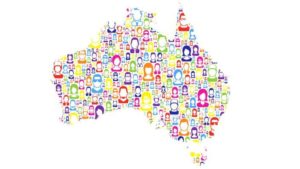Census data reveals snapshot of growing, diverse nation
As a nation, Australia is changing faster, growing more rapidly and becoming more culturally diverse, according to recently released data from last year’s census.
The Census, conducted almost ten months ago, found Australia’s population has surged to 24.4 million people by the end of 2016.
 The represents a doubling over 50 years, with nearly two million people added since the last census in 2011.
The represents a doubling over 50 years, with nearly two million people added since the last census in 2011.
Australia now has a higher proportion of migrants than the United States and Britain and, for the first time, more are moving here from Asia than Europe.
The figures showed nearly half of the current population were either born overseas or their parents were.
And of the more than six million born elsewhere, almost 20 per cent have arrived since 2012.
England and New Zealand are still the most common countries of birth after Australia but a growing number are born in China and India.
The Census found nearly a third of Australians say they have no religion – more than two million more than in 2011.
More are turning away from Christianity but there’s been a growth in Buddhism, Islam and Sikhism due to migration trends.
And the number of Australians speaking only English at home fell from almost 77 per cent to nearly 73 per cent in five years, although more than 300 different languages are spoken in households.
While the average age of an Australian is 38, – 36 for a Victorian – one in six people are over 65.
More than two-thirds of Australians live in capital cities – which are growing nearly twice as fast as the rest of the country, mostly thanks to migrants.
Sydney is still the largest city, boasting 4.8 million residents – up nearly 10 per cent in five years.
But Victoria, with 5,926,624 people, is the fastest growing state and Melbourne has been growing even faster with an extra 12.1 per cent and jumping to 4.485 million.
Wyndham, in Melbourne’s west, was the state’s fastest growing council and second across Australia with its population increasing 55,500 to 217,000.
This growth has meant the number of people who have paid off their mortgage has dropped as house prices surge.
Just 31 per cent of Australians own their home outright, down from 32.1 per cent in 2011 and from 40 per cent a quarter of a century ago.
However, the proportion of people who are paying off a mortgage is relatively steady at 34 per cent.
The data shows a slight shift towards renting, with nearly 31 per cent now paying a landlord, up from just under 30 per cent five years ago and 27 per cent in 1991.
Median rents have increased 17.5 per cent since 2011, but those with a mortgage have seen their repayments fall by an average $45 a month, the Census found.
It found New South Wales remains the most populous state, with 7,480,228 people counted, ahead of Victoria in second (5,926,624 people) and Queensland in third (4,703,193 people).
But the ACT recorded the highest population growth of any state or territory more than 40,000 new residents – an increase of 11 per cent.
Australia now has 6.1 million families although the proportion of couples with children is falling with 45 per cent now having kids compared to 54 per cent in 1991.
Meanwhile couples without children are rising as proportion of families, at 38 per cent, up from 32 per cent in 1991.
Almost half, or 48 per cent, of Australia adults are married and 35 per cent have never married.
Just over two per cent of the population are separated and 8.5 per cent are divorced and 5.2 per cent widowed. Almost 16 per cent are one parent families.
Laurie Nowell
AMES Australia Senior Journalist












